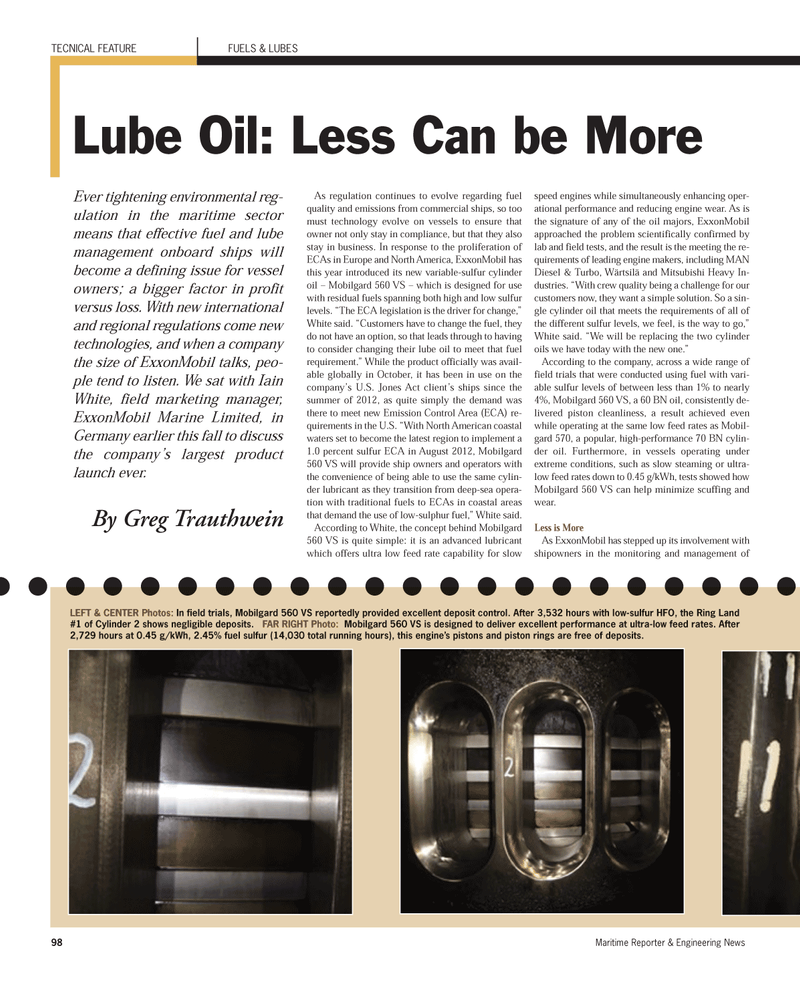
Page 98: of Maritime Reporter Magazine (November 2012)
Workboat Annual
Read this page in Pdf, Flash or Html5 edition of November 2012 Maritime Reporter Magazine
98Maritime Reporter & Engineering News As regulation continues to evolve regarding fuel quality and emissions from commercial ships, so toomust technology evolve on vessels to ensure that owner not only stay in compliance, but that they also stay in business. In response to the proliferation of ECAs in Europe and North America, ExxonMobil has this year introduced its new variable-sulfur cylinder oil ? Mobilgard 560 VS ? which is designed for use with residual fuels spanning both high and low sulfur levels. ?The ECA legislation is the driver for change,? White said. ?Customers have to change the fuel, they do not have an option, so that leads through to having to consider changing their lube oil to meet that fuelrequirement.? While the product officially was avail- able globally in October, it has been in use on the company?s U.S. Jones Act client?s ships since the summer of 2012, as quite simply the demand was there to meet new Emission Control Area (ECA) re- quirements in the U.S. ?With North American coastal waters set to become the latest region to implement a 1.0 percent sulfur ECA in August 2012, Mobilgard 560 VS will provide ship owners and operators with the convenience of being able to use the same cylin- der lubricant as they transition from deep-sea opera- tion with traditional fuels to ECAs in coastal areasthat demand the use of low-sulphur fuel,? White said. According to White, the concept behind Mobilgard 560 VS is quite simple: it is an advanced lubricant which offers ultra low feed rate capability for slow speed engines while simultaneously enhancing oper- ational performance and reducing engine wear. As is the signature of any of the oil majors, ExxonMobil approached the problem scientifically confirmed by lab and field tests, and the result is the meeting the re- quirements of leading engine makers, including MAN Diesel & Turbo, Wärtsilä and Mitsubishi Heavy In- dustries. ?With crew quality being a challenge for our customers now, they want a simple solution. So a sin- gle cylinder oil that meets the requirements of all of the different sulfur levels, we feel, is the way to go,? White said. ?We will be replacing the two cylinder oils we have today with the new one.? According to the company, across a wide range of field trials that were conducted using fuel with vari- able sulfur levels of between less than 1% to nearly 4%, Mobilgard 560 VS, a 60 BN oil, consistently de- livered piston cleanliness, a result achieved even while operating at the same low feed rates as Mobil- gard 570, a popular, high-performance 70 BN cylin- der oil. Furthermore, in vessels operating under extreme conditions, such as slow steaming or ultra- low feed rates down to 0.45 g/kWh, tests showed how Mobilgard 560 VS can help minimize scuffing and wear. Less is More As ExxonMobil has stepped up its involvement with shipowners in the monitoring and management of TECNICAL FEATURE FUELS & LUBESLube Oil: Less Can be More Ever tightening environmental reg- ulation in the maritime sectormeans that effective fuel and lube management onboard ships will become a defining issue for vessel owners; a bigger factor in profit versus loss. With new international and regional regulations come new technologies, and when a company the size of ExxonMobil talks, peo-ple tend to listen. We sat with Iain White, field marketing manager, ExxonMobil Marine Limited, inGermany earlier this fall to discussthe company?s largest product launch ever. By Greg Trauthwein LEFT & CENTER Photos: In field trials, Mobilgard 560 VS reportedly provided excellent deposit control. After 3,532 hours with low-sulfur HFO, the Ring Land #1 of Cylinder 2 shows negligible deposits. FAR RIGHT Photo: Mobilgard 560 VS is designed to deliver excellent performance at ultra-low feed rates. After 2,729 hours at 0.45 g/kWh, 2.45% fuel sulfur (14,030 total running hours), this engine?s pistons and piston rings are free of deposits. MR#11 (98-105):MR Template 11/6/2012 10:09 AM Page 98

 97
97

 99
99
